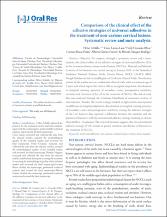| dc.contributor.author | Arbildo-Vega, Heber | |
| dc.contributor.author | Lamas-Lara, César | |
| dc.contributor.author | Cruzado-Oliva, Fredy | |
| dc.contributor.author | Rosas-Prado, Carmen | |
| dc.contributor.author | Gómez-Fuertes, Alberto | |
| dc.contributor.author | Vásquez-Rodrigo, Hernán | |
| dc.date.accessioned | 2020-06-25T17:54:05Z | |
| dc.date.available | 2020-06-25T17:54:05Z | |
| dc.date.issued | 2018-06-05 | |
| dc.identifier.citation | Arbildo H., Lamas C., Cruzado F., Rosas C., Gómez A., Vásquez H. Comparison of the clinical effect of the adhesive strategies of universal adhesives in the treatment of non-carious cervical lesions. Systematic review and meta-analysis. J Oral Res 2018; 7(5): 210-222 | es_PE |
| dc.identifier.uri | https://hdl.handle.net/20.500.12727/6262 | |
| dc.description.abstract | Objective: To compare, through a systematic review and a meta-analysis, the clinical effect of the adhesive strategies of universal adhesives (UA) in the treatment of non-carious cervical lesions (NCCLs). Material and Method: A search of the literature was carried out up to January 2018, in the biomedical databases: Pubmed, Embase, Scielo, Science Direct, SIGLE, LILACS, BBO, Google Scholar and the Central Register of Cochrane Clinical Trials. The selection criteria of the studies were as: randomized clinical trials, with a maximum age of 5 years and which report the clinical effects (marginal adaptation, discoloration or marginal staining, presence of secondary caries, postoperative sensitivity, retention and fractures) of the UA in the treatment of NCCLs. The risk of study bias was analyzed through the Cochrane Handbook of systematic reviews of interventions. Results: The search strategy resulted in eight articles that reported no difference in marginal adaptation, discoloration or marginal staining, presence of secondary caries and postoperative sensitivity among the adhesive strategies of the UA; however they reported a difference between the retention and the presence of fractures, with the conventional adhesive strategy resulting in a better clinical effect. Conclusion: The reviewed literature suggests that the conventional adhesive strategy of UAs results in greater retention and absence of fractures in the treatment of NCCLs. | es_PE |
| dc.format.extent | pp. 210-222 | es_PE |
| dc.language.iso | eng | es_PE |
| dc.publisher | Facultad de Odontología, Universidad de Concepción, Chile. | es_PE |
| dc.relation.ispartof | urn:issn:1476-1645 | |
| dc.relation.ispartofseries | Journal of Oral Research;vol. 7, no. 5 | |
| dc.relation.uri | https://doi.org/10.17126/joralres.2018.049 | es_PE |
| dc.rights | info:eu-repo/semantics/openAccess | es_PE |
| dc.rights.uri | https://creativecommons.org/licenses/by-nc-nd/4.0/ | es_PE |
| dc.source | Repositorio Académico USMP | es_PE |
| dc.source | Universidad San Martín de Porres - USMP | es_PE |
| dc.subject | Traumatismos del cuello | es_PE |
| dc.subject | Revisión | es_PE |
| dc.subject | Metaanálisis | es_PE |
| dc.title | Comparison of the clinical effect of the adhesive strategies of universal adhesives in the treatment of non-carious cervical lesions. Systematic review and meta-analysis. | es_PE |
| dc.type | info:eu-repo/semantics/article | es_PE |
| thesis.degree.name | Medicina Humana | es_PE |
| thesis.degree.grantor | Universidad de San Martín de Porres. Facultad de Medicina Humana | es_PE |
| thesis.degree.discipline | Medicina | es_PE |
| dc.publisher.country | CL | es_PE |
| dc.subject.ocde | https://purl.org/pe-repo/ocde/ford#3.02.00 | es_PE |








